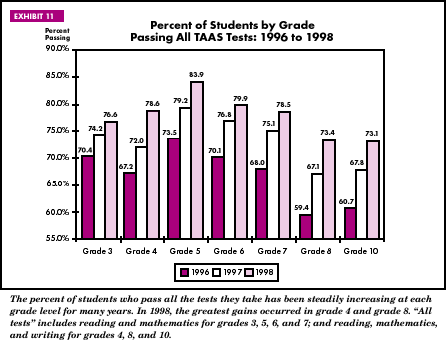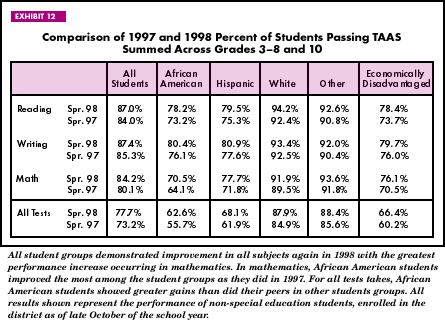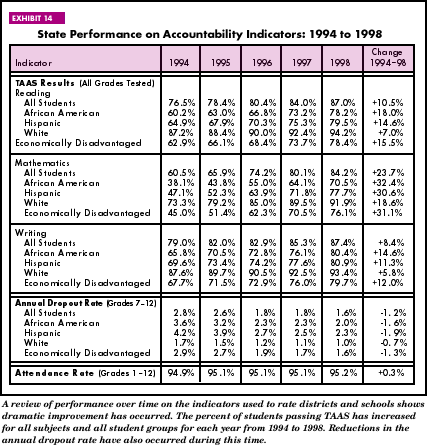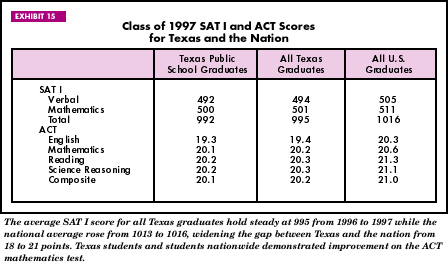
Texas Assessment of Academic SkillsThe Texas Assessment of
Academic Skills (TAAS) program is a state-administered criterion-referenced
testing program that draws its objectives from the state-mandated curriculum
established by the State Board of Education. Begun in 1990-91, the TAAS
emphasizes the assessment of academic skills and focuses on students'
higher order thinking and problem-solving skills. A major rewrite of
the curriculum, the Texas Essential Knowledge and Skills (TEKS), was
completed in the summer of 1997 and an assessment based completely on
TEKS is planned for Since 1994, the TAAS reading and mathematics assessments have been administered at grades 3-8, and 10 (exit-level) and the writing assessment has been administered at grades 4, 8, and 10. The TAAS program also includes a science and social studies component, given in grade 8. End-of-course examinations are administered to students upon completion of Biology and Algebra I. In 1998, end-of-course examinations in English II and US History were administered for the first time. TAAS results reported here reflect those used in the 1998 statewide accountability system. These are results for all students not served in special education. In addition, an adjustment for mobility is made by including only those examinees enrolled in the district at the end of October of the school year being reported. Generally, results reported are the percent of students passing tests in the subject areas of reading, writing and mathematics, summed across grades 3-8, and 10. Where the reported outcomes are the percent of students passing all tests taken, the results include reading, writing and mathematics at grades 4, 8, and 10, and reading and mathematics only at grades 3, 5, 6, and 7. These TAAS results were reported in the 1998 data tables for accountability, the 1997-98 Academic Excellence Indicator System (AEIS), the 1997-98 School Report Card, and Pocket Edition: 1997-98 Texas Public School Statistics. In all cases, the results for students receiving special education services have been excluded and the adjustment for mobility has been applied. Readers wishing to review TAAS results for all non-special education and special education students tested should request the TEA publication Texas Assessment of Academic Skills: Student Performance Results, 1997-98, or visit the Texas Education Agency's website at http://www.tea.state.tx.us. During the spring semester of 1998, over 1.5 million students were tested in grades 3-8, and 10. Reading and mathematics tests were given at all these grades. Over 640,000 students took the writing test statewide in grades 4, 8, and 10. Science and social studies tests were administered to over 220,000 students in grade 8. During 1997-98, end-of-course examinations were administered to over 230,000 Biology students in grades 8-12, and over 260,000 Algebra I students in grades 7-12. Over 190,000 students took the English II end-of-course examination, and over 170,000 took the US History end-of-course examination during the spring of 1998. While various measures can be used to interpret test results, this document focuses on the percent passing, computed as the number of students passing a test divided by the number of students taking that test. The percent passing all tests taken is the number of students passing all the tests they attempted, divided by the number of students who were tested. In this report, the "all tests taken" measure includes up to three tests: reading, writing, and mathematics. Note that for grade 8, science and social studies results are excluded from the "all tests taken" calculations reported here. The percent passing can be shown by individual grade, or for all grades tested. "All grades tested" is computed using counts of passers and test takers summed across grades 3-8, and 10. Exhibit 10 below, shows spring 1998 TAAS results by grade and subject. Among the subjects tested, the percent passing is highest for writing, followed by reading and then mathematics; a pattern that has held for the past five years. The lowest pass rates by subject and grade are: reading in grade 8 (85.3), mathematics in grade 10 (78.4), and writing in grade 8 (84.0). The highest pass rates by subject and grade are: reading in grade 4 (89.7), mathematics in grade 5 (89.6), and writing in grade 10 (89.9). Statewide in 1998, 77.7 percent of the students in all grades tested passed all the tests they took. This is an improvement of 4.5 percentage points over the spring of 1997 when 73.2 percent of the students passed all tests taken. The rate is 22.1 percentage points higher than the spring of 1994 results when 55.6 percent passed all tests taken.
Exhibit 11 below, shows the percent of students passing all tests taken by grade, for 1996 to 1998. The percent passing rates show steady improvement in all grades over the past three years. In 1998, passing rates for all tests taken were lowest in grade 10 (73.1) and highest in grade 5 (83.9).
For the fourth consecutive year, the greatest gains in performance occurred in mathematics. Exhibit 12 below, shows that performance in mathematics improved from 80.1 percent passing in 1997 to 84.2 percent passing in 1998. All student groups improved in this subject, with increases ranging from 1.8 percentage points for "other" (Asian/Pacific Islander and Native American) students, to 6.4 percentage points for African American students. Hispanic students improved on mathematics by 5.9 percentage points while economically disadvantaged students improved by 5.6 percentage points. Writing results increased by 2.1 percentage points over 1998, from 85.3 to 87.4 percent passing. Reading increased 3.0 points, from 84.0 percent passing in 1997 to 87.0 percent in 1998. As in mathematics, African American students achieved the greatest percentage point gains among the student groups in writing (4.3) and in reading (5.0).
Minority students, as shown in Exhibit 12 above, continue to show performance gains in all subjects. Each year since 1994, the disparities in performance among the major ethnic groups in Texas have narrowed. Between 1994 and 1998, differences in performance between African American and White students have decreased in reading from 27.0 to 16.0 percentage points, in mathematics from 35.2 to 21.4 percentage points, and in writing from 21.8 to 13.0 percentage points. During this same time, differences in performance between Hispanic and White students have decreased in reading from 22.3 to 14.7 percentage points, in mathematics from 26.2 to 14.2 percentage points, and in writing from 18.0 to 12.5 percentage points. Although these decreases in the disparities in performance are encouraging, it is clear that efforts must continue to close these gaps. In 1998, 62.6 percent of African American students and 68.1 percent of Hispanic students passed all tests taken compared with 87.9 percent of White students and 88.4 percent of Asian/Pacific Islander and Native American students. Economically disadvantaged students had passing rates 11.3 percentage points lower than statewide rates and 19.8 percentage points lower than passing rates of non-economically disadvantaged students. The statewide accountability system holds districts and campuses responsible for student group performance in order to focus attention on the performance of all students and reduce these disparities. By law, districts must offer remediation to students failing to pass a test in a subject area. Statewide, in grades 3-8 and 10, over 347,000 students (22.3 percent) required remediation after the 1998 TAAS administrations. This figure is lower than the over 412,000 students (26.8 percent) who required remediation due to failing one or more TAAS tests at grades 3-8, and 10 in 1997. The state compensatory allotment supports this remediation, although it is allocated to districts based on counts of economically disadvantaged students, not the number of students requiring these services. Students failing to pass the exit-level test are not eligible to receive a Texas high school diploma. However, beginning in 1997 local school districts in Texas have the option to offer certificates of completion for these students if they have met all other graduation requirements. Among sophomores taking the March 1998 TAAS exit-level test, over 56,000 (26.9 percent) failed one or more of the subject areas. These students will have seven more opportunities to master the exit-level TAAS test before the end of their senior year as the class of 2000. Beginning with the class of 1996, a measure of the cumulative pass rate on the exit-level test has been reported in the Academic Excellence Indicator System. Results for the class of 1998 are based on the percent of students who first took the exit-level test in the spring of 1996 and finished testing in the same school district by May 1998. Results for this measure are directly comparable to the class of 1997 and class of 1996 cumulative pass rates reported in editions of Snapshot from 1995-96 to date, but are not comparable to the proxy measures reported in previous editions. Statewide results indicate that 23,945 students from the class of 1998 did not pass one or more sections of the exit-level TAAS test. This represents an estimated cumulative passing rate of 88.7 percent for the class of 1998, and an improvement over the cumulative passing rate of 86.6 percent for the class of 1997. District-level passing rates for science and social studies are not provided in this publication. Statewide results show that 84.3 percent of 8th grade students passed the science assessment and 69.9 percent passed social studies. Performance patterns among student groups on both these tests were similar to those for reading, writing, and mathematics. For details on the results of these assessments, as well as for the end-of-course examinations, see Texas Assessment of Academic Skills: Student Performance Results, 1997-1998. Accountability Rating System for Texas Public SchoolsBeginning in 1994, ratings for Texas public schools and school districts have been based on a consistent set of mandated indicators. These indicators are performance on the reading, writing, and mathematics portions of the TAAS; dropout rates; and attendance rates. As required by statute, overall performance of all students as well as the performance of student groups (African American, Hispanic, White, and Economically Disadvantaged) are evaluated. Student groups must meet minimum size requirements to be included in the evaluation. In 1998, each district received a rating of either Exemplary, Recognized, Academically Acceptable, or Academically Unacceptable. Districts may also be rated as Unacceptable: Special Accreditation Investigation, for reasons other than student performance. In 1998, schools were rated as Exemplary, Recognized, Acceptable, Low-Performing, Alternative Education: Acceptable, Alternative Education: Needs Peer Review, or Alternative Education: Not Rated. Districts and campuses were also evaluated on three measures for which they could receive additional acknowledgment. These measures, which do not affect the rating for a school or district, are the results of college admissions participation and performance, the percent of students meeting the TAAS/TASP equivalency, and Comparable Improvement (see Endnotes for brief descriptions of these latter two measures). Specific details regarding
how accountability ratings were calculated are contained in the Accountability
Manual:
In 1998, 1,048 schools were rated Exemplary. This is an increase of 365 schools over the number rated Exemplary in 1997. The number of Low-Performing schools decreased from 67 in 1997 to 59 in 1998. Of the 59 schools rated Low-Performing in 1998, 42 received this rating due to poor performance on TAAS, (16 on mathematics, three on reading, 17 on writing and 6 on a combination of subjects); 14 received the rating due to a high dropout rate; two received it as result of a data inquiry; and the remaining school received the rating due to a combination of a high dropout rate and poor performance on TAAS. Exhibit 14 below, shows the changes in performance on the accountability indicators between 1994 to 1998. As shown in the table, performance on the TAAS has risen dramatically, especially among the student groups and particularly in the percent of students passing the mathematics portion of the TAAS. The dropout rate has declined and the attendance rate has risen slightly over the same period. These improvements reflect the efforts of educators, parents, and students statewide to meet the expectations of the accountability system.
College Admissions TestsIn Texas, almost 64 percent of 1996-97 public high school graduates participated in college admissions testing. Of the class of 1997, over 100,000 took either the SAT I, the ACT, or both tests. The ACT is the ACT Assessment administered by ACT, Inc. The SAT I is the SAT I: Reasoning Test of the College Board's SAT Program. It is a revised but comparable test that was introduced in March 1994 to replace the Scholastic Aptitude Test. Nationwide, approximately 42 percent of all graduates took the SAT I and 36 percent took the ACT. In Texas, 49 percent of all graduates took the SAT I, and 30 percent took the ACT. For both Texas and the nation, "all graduates" includes public and nonpublic school students. The SAT I consists of verbal and mathematics components. Scores on the verbal and mathematics sections of the SAT I range from 200 to 800 and sum to the SAT I total score, which ranges from 400 to 1600. The ACT includes tests of reading and science reasoning in addition to English and mathematics. Each subject area component of the ACT has a score ranging from 1 to 36. The composite is the average of these four scores. Beginning with the class of 1996, SAT I scores have been reported on a recentered scale by the College Board. The 1996-97 edition of Snapshot was the first edition to report performance on the SAT I. Thus, SAT scores reported in earlier editions of Snapshot, because they are based on the original scale, cannot be directly compared to class of 1996 and class of 1997 recentered scores. Exhibit 15 below, shows the average SAT I and ACT scores for all graduates for Texas and the nation. In addition, the averages for just the public school graduates in Texas are shown. Average college admissions scores for all Texas graduates for the class of 1997 were below the national averages. Texas' average SAT I total score was 21 points lower than the national average (995 versus 1016). The ACT composite was 20.2 for all Texas graduates compared to 21.0 for the nation. Scores for public school graduates were slightly lower than those for all Texas graduates--three points lower on the SAT I total, and 0.1 lower on the ACT composite.
It is encouraging that both SAT I and ACT performance for all Texas class of 1997 graduates held steady as the numbers tested increased substantially over the past year--up 5.3 percent for both tests in Texas, compared to 3.9 percent and 3.7 percent increases in SAT I and ACT examinees nationally. In Texas, there were 94,034 SAT I-tested graduates, the highest number ever, while the second highest number of ACT-tested graduates (58,395) was recorded. Students who take the SAT I report information to the College Board on their academic preparedness, parental education, and family income. Students' SAT I scores tend to rise with increasing numbers of academic courses completed, higher levels of parental education, and higher levels of family income. Exhibit 16 below, shows the relationship between years of study in academic subjects and SAT I total scores.
Similar relationships exist with ACT test score results. The average ACT composite score for Texas students who took a college preparatory high school program, defined as four years of English and three years each of mathematics, social studies, and natural sciences, is 21.2, which is 3.2 points higher than the average score for students who did not complete such a program. Lower levels of academic preparedness offer one possible explanation for the lower SAT I and ACT test scores of African American and Hispanic students relative to scores of White and Asian students. Information from the test contractors shows that in Texas, the African American and Hispanic students who take college admissions tests have completed fewer academic courses compared to the White and Asian/Pacific Islander tested students. An additional data element derived from the college admissions testing program is the percentage of public school examinees scoring at or above the accountability criterion score (1110 on the SAT I; 24 on the ACT). This standard of excellence was met or exceeded by 26.6 percent of the class of 1997, a slight increase over the 26.3 percent achieved by the class of 1996. Note that prior to 1996 this measure was defined as the percentage of graduates, not examinees, scoring at or above the criterion. |






